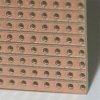Hi Rorut,
Below is a schematic which you may like to try. The values of the capacitors are not critical but the two 100nF decoupling capacitors should be ceramic or polypropylene types and need to be mounted with short leads and as close to the opamp supply pins as possible.
Also if you can make the layout follow the layout indicated on the schematic that will help prevent oscillations. The order of the 0V line connections are particularly important.
spec

Below is a schematic which you may like to try. The values of the capacitors are not critical but the two 100nF decoupling capacitors should be ceramic or polypropylene types and need to be mounted with short leads and as close to the opamp supply pins as possible.
Also if you can make the layout follow the layout indicated on the schematic that will help prevent oscillations. The order of the 0V line connections are particularly important.
spec



